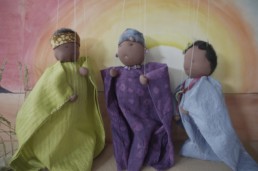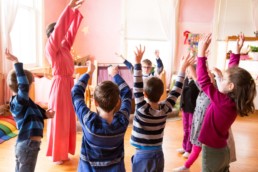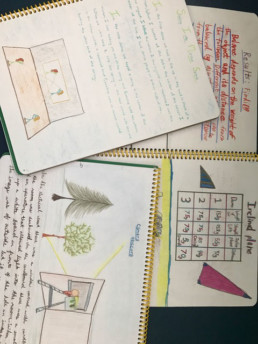of fiber & folktales
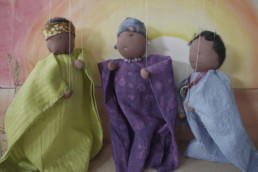
In Fiber Arts teacher Barbara Freiberg’s classroom, Susquehanna Waldorf School’s Class 7 students busily transform lengths of thread and swatches of fabric into playful marionettes for their May performance of “Folktales from Africa.” The work is fun—but it is also grounded in the classwork and the student’s developmental needs.
The marionette play is, as all class plays in Waldorf education are, connected to one of the curriculum blocks. For Class 7, the “Folktales” play reinforces and enriches their study of Africa. Touching on geography, culture and people of the different African regions, the marionettes, alongside other art-centered projects, carry the goal of a deeper experience with the subject matter.
In addition to bringing the curriculum to life, class plays at SWS meet students where they are developmentally and seek to address the struggles felt by the particular age group. Class 7 students entering adolescence, a stage of heightened self-awareness, find comfort in their role working with marionettes, as they can reveal their character behind the scenes instead of out in the spotlight. The teacher is able to stretch the skills and capacity in students this way, but from a place that is comfortable for their age. The play also strengthens the sense of interdependence among the whole class, and uncovers a new appreciation for each other.
As each puppet dances lightly from the marionette strings, Class 7 students smile and recite the lines they have worked diligently to memorize. How they enter their character and respond to each other through practice prepares them for their performance, as well as their final eighth grade production in the coming year, but it also prepares them for life—a gift that goes well beyond the stage.
sws 2017-2018 annual report
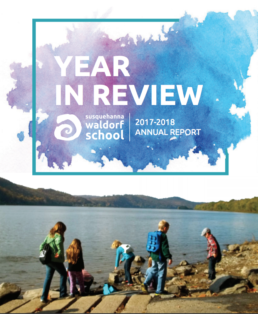
On behalf of the faculty and Board of Trustees at SWS, we are excited to present our 2017-2018 Annual Report. The magic of our school continues to work its wonders in educating and developing the children that have been entrusted to our care. In light of the challenges of our modern world, Waldorf education continues to provide much needed focus on the developmental needs of the child. The results are tangible — one walk through the hallways of our wonderful building makes that apparent.
As always, we welcome input from any member of the school community. We look forward to continuing this journey with our parents, alumni, friends of the school and most important, our children.
Eurythmy Students Journey to Make Speech Sing
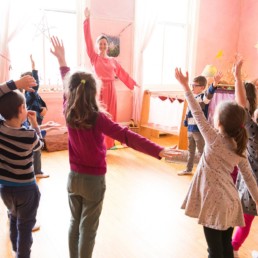
On Friday, March 2nd, the Susquehanna Waldorf School hosted their annual Spring Eurythmy assembly. With Eurythmy Teacher Katie O’Brien’s bright eyes and graceful, sweeping gestures, each grade took the center of the gym in turn, painting an artistic picture for the audience of how human beings can work and move together, and make their bodies sing.
To an onlooker who didn’t know, one might find it difficult to distinguish eurythmy from a form of dance. It was, in fact, a young dancer who came to Rudolf Steiner, the founder of Waldorf education, and said, “I want to bring something new to movement. Something is missing.” This sparked the inauguration of eurythmy, an entirely new form of expressive movement art unique to Waldorf education. By definition, eurythmy is “a system of harmonious body movement to the rhythm of spoken words.” In dance, it is the physical form and exact body position that are paramount; eurythmy, in contrast, is about bringing words and sounds into formation, using the human body in motion as its instrument. Sound and gesture are united as the body becomes the vowels, consonants, and music being played. It is an art that makes a nod to the heart and the inner life, acknowledging that what we hear is not just audible, but also harnesses an emotional and physical hold.
Opening the March 2nd assembly, the younger students trickled down from the bleachers into a circular formation as O’Brien recited a poem, then knitted the circle into an increasingly intricate spiral as the pace of the verse increased. Movements flowed seamlessly with the consonants and vowels, keeping pace with the quick alliteration of lines like “bright are the sparks; sparks kindle light.” As the assembly continued, the classes expressed a progression towards more complex coordination and greater sensitivity to the space between their peers, forming shapes with their bodies that seemed invisibly tethered to the sounds and the surroundings.
Year by year, students of eurythmy at the Susquehanna Waldorf School are guided through exercises that are aligned developmentally to nurture intelligent hands and feet and, in turn, a thoughtful, thinking heart. It is a holistic approach to movement. Every consonant and vowel in eurythmy has its own sound and archetypal gesture; “b,” for instance, becomes alive in the verse as the “bear,” hands stretching the air apart like opening the bellows of an invisible accordion. “The gift of eurythmy,” says O’Brien, “is that the child can learn to experience themselves gracefully, maintain space thoughtfully, and move harmoniously with others.” When a student new to eurythmy, for instance, is instructed to walk backwards, they instinctively feel the need to look over their shoulder. “Gradually, they stop looking: they learn to trust themselves and the world they can’t see,” notes O’Brien.
This individual mastery that eurythmy cultivates also stimulates a deep sensitivity to others. In one Waldorf school, a basketball coach, impressed by the harmonious movement of the opposing team, asked the Waldorf coach how he was able to foster such orchestrated movement in his players. On overhearing this question, a teammate interjected that is was a result of their eurythmy training.
As the Spring Assembly came to a close, parents were encouraged to stay for a brief eurythmy lesson. O’Brien asked the small group to first form a circle; after forming something reminiscent of a squiggly star, then a lopsided oval, the parents were at last corralled into something more concentric. “Waldorf students are capable of making circles very quickly and accurately,” O’Brien commented with a smile. This spatial awareness is also seen in Waldorf geometry classes, where students are able to draw circles freehand that look like they were crafted with the precision of a compass tool.
“Eurythmy teaches you to find your center,” says O’Brien. Through the concentration, self-discipline, and sense of beauty that eurythmy instills, students at the Susquehanna Waldorf School are ultimately inspired by a shared intention to live harmoniously, within themselves and with others.
from the early grades and beyond, students give shape to geometry
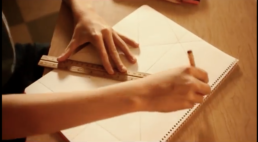
For students studying geometry at the Susquehanna Waldorf School, precision is compatible with beauty. Each student’s lesson book not only illustrates their knowledge and understanding, but also showcases their individual creativity and personality as they add their own color and shading to their construction. The result is a classroom brimming with richly colored and rigorously made shapes, integrally tied to mathematical understanding.
“We want the students to understand visually how the formulas work, not just memorize the formulas,” explains Leilani Richardson, Grade 6 teacher. As early as Grade 2, students begin laying the groundwork for geometry by creating form drawings and exploring multiplication through a circular times table. This advances to connecting points on a page with a ruler, and goes on to yield an exponentially broader range of form and color as students learn to bisect lines and angles. The technical terminology advances with the drawings, introducing the names of angles, line segments, and concepts. By the time the students reach the higher grades, they are well prepared for the rigor of constructing complex shapes and grasping advanced theories.
Constructing the shapes in the higher classes takes an enormous amount of focus and self-discipline. Pedagogically, this touches on a key aspect of the students’ development. “At this age, their bodies and their inner world are askew. They are growing and changing so rapidly, and the work to create these geometric drawings brings order and focus to their thinking. It is very comforting to them,” says Richardson. Students are also given an opportunity for self-discovery and self-direction. In one exercise, students are asked to determine the area of a triangle with just a square of paper. Not only does this encourage the student to find the connection independently, but it also gives them an opportunity to clearly express their discovery in words and in a mathematical language.
Beginning in the early grades as simple form drawings and progressing into the higher classes as meticulously constructed shapes, geometry in the Waldorf curriculum goes beyond the calculations and formulations to get at the very essence of shapes. It is a development of mathematical thinking that creates an understanding of the whole to the parts, and connects its students to the source.
SWS Students Become Force, Weight and Motion in Middle School Physics
The methodology for science instruction in Waldorf Education is based on observation and Socratic Inquiry. Students of all ages are immersed in observation and manipulatives, experienced during regular nature walks, gardening, cooking, form drawing and experimentation, to name only a few. By the time they enter middle school, Waldorf students begin the study of Physics, Chemistry, Anatomy, Physiology, Geology, Astronomy, Meteorology, and Botany, which is first introduced in fifth grade. At this level, Waldorf teachers begin not by lecturing on rules and formulas, but by showing those rules in action through experiments, the natural world, art and music. These real world examples and applications are used to then guide students to use Socratic inquiry and observation to connect logical parts to the whole, which helps them deeply understand the science within our world.
At Susquehanna Waldorf School, the seventh grade recently reinforced that science can come to life as they demonstrated their Physics and Simple Machine experiments to the student and parent body at a school assembly. Using themselves as weight, force, and motion, they were able to affect balance through a fulcrum, lifting through pulleys, force from a small wedge, and motion with the help of wheels and axles.
Other experiments and demonstrations the seventh grade participated in during their Physics block were building a simple motor as part of their study of electricity, identifying reflections and images in mirror space observations, and conceptualizing the complex workings of the camera obscura. As a final lesson review, and unique to Waldorf education, students then explained (composed) and illustrated what they learned in their self-made textbooks, also known as main lesson books.
A study of Waldorf alumni, conducted by AWSNA, the Association of Waldorf Schools of North America, found that Waldorf graduates are almost two times more likely than the usual U.S. graduate to declare majors in Math and Science. This may be attributed to the creative and imaginative capacities developed and explored first in the lower grades and then into the middle school Waldorf science classes.
Postcard Exchange Helps Students Broaden Horizons
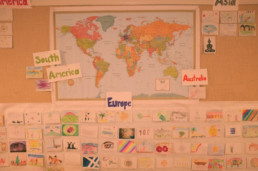
The Susquehanna Waldorf School (SWS) is participating in a worldwide postcard exchange initiative to both broaden the global perspective of students and kick-off the 100 year celebration of Waldorf® Education planned for 2019.
Throughout the current year, students in 1,100 Waldorf schools from greater than 80 countries will send a postcard to every other Waldorf school in the world. Each postcard is being individually designed by a young person, telling or showing something of his or her country, school, or self.
This innovative global project will connect hundreds of thousands of students to one another through individualized and artistically designed postcards, which will then be arranged, by each school, into a Global Map for public display.
SWS is proud to be a part of this million-fold Waldorf greeting from around the globe! Class Five teacher, Elizabeth Curtis, shares that her students “eagerly anticipate arrivals of cards from far-away lands” and are finding connection with other Waldorf students through the process.
See how students are broadening their horizons!

